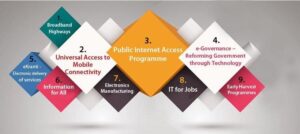About Digital India Mission
- Digital India is an umbrella programme that covers multiple Government Ministries and Departments.
- It weaves together a large number of ideas and thoughts into a single, comprehensive vision so that each of them can be implemented as part of a larger goal.
- Each individual element stands on its own, but is also part of the larger picture.
- Digital India is to be implemented by the entire Government with overall coordination being done by the Department of Electronics and Information Technology (DeitY).
Nine Pillars Digital India Mission
- Digital India aims to provide the much needed thrust to the nine pillars of growth areas, namely Broadband Highways, Universal Access to Mobile Connectivity, Public Internet Access Programme, e-Governance: Reforming Government through Technology, e-Kranti – Electronic Delivery of Services, Information for All, Electronics Manufacturing, IT for Jobs and Early Harvest Programmes.
- Each of these areas is a complex programme in itself and cuts across multiple Ministries and Departments

Broadband Highways
- There include three components of broadband highways namely Rural Broadband, Urban Broadband and National Information Infrastructure.
Universal Access to Mobile Connectivity
- This includes to increase mobile network penetration in the country and spread the connectivity to all uncovered villages.
Public Internet Access Programme
- This includes establishments of Common Service Centres and Post Offices as multi-service centers.
- The government plans to establish around 2.5 Lakh Common Service Centres i.e. one in each Gram Panchayat. Further, all the 1.5 Lakh post offices are to be converted into multi-service centers.
E-Governance: Reforming Government through Technology
- It encompasses the development and modification of governance by means of digital knowledge.
- This contains popularization of forms, utilization of online platforms like a Sales quote software to acquire elementary government documents and services, incorporation and managing of services such as UIDAI, Payment Gateway, Mobile Platform, Electronic Data Interchange etc. use of records rather than paper-built guides and registers; mechanization of workflow within the government, and protest redressal through IT infrastructure
E-Kranti
- 10 more missions were supplemented with NeGP to demand it E-Kranti. It is a significant support of the Digital India programme. Some of these are:
- E-Education
- E-Healthcare
- Technology for Farmers
- Technology for Security
- Technology for Financial Inclusion
- Technology for Justice
- Technology for Planning
- Technology for Cyber Security
- One of the highlights of Digital India is to intensify the way into information for countries by endorsing pen data stages and open basis programmes and applications.
Electronics Manufacturing
- This includes making efforts in the direction of reaching remaining zero imports in electronics items for example FABS, Set Top Boxes, VSATs, Mobiles, Consumer electronics and so on. Government support includes subsidies, tax sops, and funds mobility for incubators, start-ups, clusters, skill development etc.
IT for Jobs
- It facilitates the training of individuals from smaller towns and villages for IT sector jobs.
Early Harvest Programmes
- This comprises numerous programmes including mass messaging platforms and apps for broadening information with respect of government programmes, E-greetings to substitute the government greetings, biometric attendances in government offices, Wi-Fi in all universities, public Wi-Fi spots, replacing books by E-Books, SMS -built disaster alerts, a national gateway for Lost and Found children etc.
Information for All
- The development of an open data platform was initiated by the Government in order to offer various projects and related data to all common people through the internet platform (data.gov.in).
- MyGov.in, a website launched by the government to engage citizens to get their suggestions and ideas over the online platform.
- As a part of this initiative, the Government planned to engage with citizens through social media and the above-mentioned website.
















